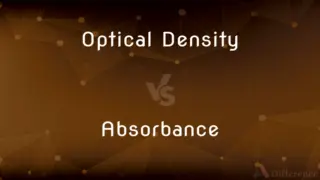Harmonium vs. Piano — What's the Difference?
Edited by Tayyaba Rehman — By Urooj Arif — Updated on May 3, 2024
Harmonium produces sound by pumping air through reeds, ideal for continuous tones; piano strikes strings with hammers, allowing for dynamic expression.

Difference Between Harmonium and Piano
Table of Contents
ADVERTISEMENT
Key Differences
A harmonium, often used in Indian classical music, creates sound as air flows over reeds, producing a constant, droning sound. On the other hand, a piano generates sound by hammers striking strings, which can be dampened to vary the note's duration.
Harmoniums are generally more portable and less sensitive to environmental changes, making them suitable for a variety of settings. In contrast, pianos are large and sensitive to humidity and temperature, requiring more stable environments.
The playing technique for a harmonium involves using a hand to operate a bellows while playing the keys with the other, which emphasizes legato and sustained notes. Conversely, piano playing uses both hands on the keys, allowing for a broader range of expression through dynamics and rhythm.
Harmoniums typically have fewer keys than pianos, limiting their range and versatility in Western classical music. However, pianos have up to 88 keys, facilitating greater musical complexity and a wider octave range.
In terms of maintenance, harmoniums require regular tuning of reeds and servicing of the bellows, while pianos need periodic tuning, regulation, and potentially costly repairs for their mechanical components.
ADVERTISEMENT
Comparison Chart
Sound Production
Air pumped over reeds
Hammers striking strings
Portability
Generally portable
Large and stationary
Musical Expression
Limited dynamics, continuous tone
Wide dynamics, controlled duration
Key Range
Fewer keys, limited range
Up to 88 keys, extensive range
Maintenance
Bellows and reeds servicing
Tuning, regulation, mechanical repairs
Compare with Definitions
Harmonium
Often used in folk and religious music.
The harmonium is a staple in kirtan sessions.
Piano
Requires regular tuning and maintenance.
The piano tuner meticulously adjusted each string to perfect pitch.
Harmonium
A free-standing musical keyboard instrument similar to a reed organ.
The harmonium’s soothing tones complemented the choir’s voices.
Piano
Used extensively in both solo and ensemble settings.
The concert pianist prepared for her piano solo at the symphony.
Harmonium
Features a range of stops and drones.
He adjusted the harmonium’s stops to alter the sound texture.
Piano
Capable of a wide range of dynamics and expressions.
He expressed his emotions through the dynamic crescendos and decrescendos of the piano.
Harmonium
Operated by pumping air through a bellows.
She played the harmonium by expertly pumping the bellows with one hand.
Piano
Has pedals to sustain or dampen the sound.
She used the piano’s sustain pedal to prolong the melody’s resonance.
Harmonium
Primarily monophonic or with limited polyphony.
The harmonium player layered simple chords under the melody.
Piano
A large musical instrument with a keyboard, metal strings, and hammers.
Her new piano filled the room with its rich, vibrant sound.
Harmonium
A keyboard instrument in which the notes are produced by air driven through metal reeds by foot-operated bellows.
Piano
The piano is an acoustic, stringed musical instrument invented in Italy by Bartolomeo Cristofori around the year 1700 (the exact year is uncertain), in which the strings are struck by wooden hammers that are coated with a softer material (modern hammers are covered with dense wool felt; some early pianos used leather). It is played using a keyboard, which is a row of keys (small levers) that the performer presses down or strikes with the fingers and thumbs of both hands to cause the hammers to strike the strings.
Harmonium
An organlike keyboard instrument that produces tones with free metal reeds actuated by air forced from a bellows.
Piano
A large keyboard musical instrument with a wooden case enclosing a soundboard and metal strings, which are struck by hammers when the keys are depressed. The strings' vibration is stopped by dampers when the keys are released and can be regulated for length and volume by two or three pedals.
Harmonium
(music) A small keyboard instrument that consists of a series of reed pipes, which sound when one of the keys is pressed to open a valve that allows air to pass through.
Piano
A passage performed or marked to be performed softly.
Harmonium
A musical instrument, resembling a small organ and especially designed for church music, in which the tones are produced by forcing air by means of a bellows so as to cause the vibration of free metallic reeds. It is now made with one or two keyboards, and has pedals and stops.
Piano
(especially as a direction) soft or softly.
Harmonium
A free-reed instrument in which air is forced through the reeds by bellows
Piano
(especially as a direction) soft or softly.
Piano
A musical instrument with a manual keyboard actuating hammers that strike wire strings, producing sounds that may be softened or sustained by means of pedals.
Piano
A passage to be played softly or quietly.
Piano
In a soft or quiet tone. Used chiefly as a direction.
Piano
(musical instruments) a percussive keyboard musical instrument, usually ranging over seven octaves, with white and black colored keys, played by pressing these keys, causing hammers to strike strings
The piano in his house takes up a lot of space.
She has been taking lessons for many years and now plays piano very well.
Piano
To play the piano.
Piano
(of or with fingers) To move (the fingers) up and down on, similar to the motions of a pianist playing the piano.
Piano
To equip with a piano.
Piano
To become softer and less intense.
Piano
(music) softly, as a musical direction (abbreviated to p. in sheet music)
Piano
(music) Soft, quiet.
Piano
(in extended use) Gentle, soft, subdued.
Piano
Soft; - a direction to the performer to execute a certain passage softly, and with diminished volume of tone. (Abbrev. p.
Piano
A well-known musical instrument somewhat resembling the harpsichord, and consisting of a series of wires of graduated length, thickness, and tension, struck by hammers moved by keys.
Piano
A stringed instrument that is played by depressing keys that cause hammers to strike tuned strings and produce sounds
Piano
(music) low loudness
Piano
Used chiefly as a direction or description in music;
The piano passages in the composition
Piano
Used as a direction in music; to be played relatively softly
Common Curiosities
Which instrument is more portable, harmonium or piano?
Harmonium.
How does a piano produce its sound?
By hammers striking strings.
What is the primary sound mechanism of a harmonium?
Air blown over reeds.
What kind of maintenance does a harmonium require?
Tuning of reeds and servicing of the bellows.
How often does a piano need tuning?
Typically, twice a year depending on usage and environment.
How does the range of a piano compare to that of a harmonium?
Piano has a much wider range.
Can a piano express dynamics more effectively than a harmonium?
Yes, due to its ability to control the intensity of each note.
What type of music is the harmonium commonly used for?
Religious and folk music.
Are harmoniums used in Western classical music?
Rarely, as they are more common in Indian music.
Is the piano suitable for both solo and ensemble use?
Yes, it is versatile for both.
Share Your Discovery

Previous Comparison
Premises vs. House
Next Comparison
Dextrose vs. SucroseAuthor Spotlight
Written by
Urooj ArifUrooj is a skilled content writer at Ask Difference, known for her exceptional ability to simplify complex topics into engaging and informative content. With a passion for research and a flair for clear, concise writing, she consistently delivers articles that resonate with our diverse audience.
Edited by
Tayyaba RehmanTayyaba Rehman is a distinguished writer, currently serving as a primary contributor to askdifference.com. As a researcher in semantics and etymology, Tayyaba's passion for the complexity of languages and their distinctions has found a perfect home on the platform. Tayyaba delves into the intricacies of language, distinguishing between commonly confused words and phrases, thereby providing clarity for readers worldwide.















































